London County Council Tramways
Summary
London County Council began its tramway ownership journey in 1894 by serving notice to compulsorily purchase those lines of the London Street Tramways Company that would reach their 21-year expiry date the following year. Although these lines were immediately leased back to the LSTCo following purchase, the LCC actually had much bigger plans, namely, to control, electrify and operate all the tramway lines within its jurisdiction. It subsequently moved into tramway operation in 1899, when it purchased the London Tramways Company, finishing its acquisition spree in 1906 with London's last independent horse tramway operator, the London Southern Tramways Company. Perhaps surprisingly, although the LCC began electric services in May 1903, it wasn't until 11 years later (in August 1914) that it ran its last horse tram service.
The LCC began its operating career in 1899 by taking over the services of the erstwhile London Tramways Company, and quickly imposed a standard uniform policy across all the former company systems. Conductors were issued with dark-blue, double-breasted uniform jackets made of serge, with four pairs of buttons (carrying the standard LCC monogram — see link) and lapels; the jacket collars were probably plain. Drivers on the other-hand were initially only issued with heavy-duty, double-breasted, greatcoats, though in later years (probably around the time of electrification), they were eventually issued with jackets too. The greatcoats were almost certainly changed to a lancer style (i.e., with button pairs narrowing from top to bottom) at the same time as lancer-style jackets were introduced for all tramwaymen (circa 1903/1904).
As far as headgear is concerned, horsecar drivers were issued with brown bowler hats that bore one-piece brass 'LCC' block capitals cap badges; this pattern of badge has the feel of a 'stop gap', and was probably issued to other municipal employees as well. Conductors were issued with squat, soft-topped caps with a glossy peak; the caps carried a brass cap badge incorporating a wreath with script initials ('LCC') in the centre. This badge was identical in form to that used by the London Tramways Company, save for the initials in the centre. In later years, the initials were possibly changed to 'LCCT', perhaps at the same time that cloth 'LCCT' motormen's cap badges were introduced (see below). Given that the management of the erstwhile London Tramways Company formed the core of the new LCCT, it is perhaps no surprise that the first uniforms, buttons and badges were effectively direct descendents of those used by the tramway company.
At some point, and possibly to mark the introduction of the first electric services in 1903, motormen, horsecar drivers and conductors were issued with double-breasted, lancer-style tunics made of navy-blue serge. The jackets had five pairs of buttons (narrowing from top to bottom) and high fold-over collars, the latter being plain, i.e., they did not carry badges or insignia of any kind. Both the jackets and trousers were embellished with red piping. Around the same time, the caps appear to have been changed to a more contemporary tensioned-crown design with a glossy peak. Conductors continued to wear the brass wreath badge, though possibly subtly altered to include 'LCCT' in the centre (this is unclear); in contrast, motormen's caps carried an oval cloth badge that bore block-capital ('L C C') initials above a 'T', with the grade ('MOTORMAN') beneath. Motormen (only) were also issued with long, double-breasted greatcoats with six pairs of buttons (narrowing slightly from top to bottom) and high, fold-over collars; the latter were again devoid of insignia. Conductors were not issued with greatcoats, but did receive lighter-weight jackets for use in summer.
Around the end of the Great War, a brass, voided (i.e., open-backed) cap badge was introduced for motormen; like the cloth badges, this carried block-capital initials ('L C C') above a letter 'T' and the grade, 'MOTORMAN' (see below). The jackets were changed yet again in the 1920s, and whilst still double-breasted, and heavy duty, they now bore lapels.
Motormen and conductors always appeared in service wearing enamel Public Carriage Office licences, which were issued by the Metropolitan Police (see link).
Several studio portraits of more senior grades have survived, including regulators and inspectors. The jackets worn in the first year of operation (1899) appear to have been very similar to those worn by conductors, i.e., double-breasted with four pairs of buttons, the top pair being visible through the lapels, the collars being plain. Caps were soft topped with braiding on the peak, and with a hat band of a lighter colour; the latter bore the same style of 'initials and wreath' cap badge worn by conductors. At some point, probably around 1900-1903, the jackets were changed to a new style, still double-breasted with four pairs of buttons and lapels, but with gold-thread embroidered block-capitals ('L C C') on the collars; the buttons on the jackets were black horn. The old soft-topped caps were superseded by tensioned-crown peaked caps; these bore cloth cap badges identical in form to those issued to motormen, but with the grade 'INSPECTOR' or 'REGULATOR', etc., and embroidered in gold thread. These caps appear, not to have lasted long, soon being superseded by drooping-peak caps, the cap badge, however, remaining the same.
In 1920, the senior staff headwear reverted to tensioned-crown peaked caps, initially with the old cloth cap badges, though they were eventually replaced by a new style of circular metal cap badge; these badges bore script-lettering initials ('LCCT') in the middle, with the grade around the outside in block capitals. They were made in two materials, a dull grey metal ('TICKET INSPECTOR' and 'REGULATOR' are known) and gilt ('DISTRICT INSPECTOR' is known).
A few examples of an oval brass cap badge have also survived for the grade of 'ASSISTANT REGULATOR' (see below); it is currently unclear why this grade was issued with a different shape of cap badge to other senior grades.
It seems highly likely that the most senior grades (e.g., district inspector) wore more elaborate uniforms than inspectors and regulators; details are, however, elusive.
In common with the majority of tramway operators, the LCC employed women during the Great War (from the 30th November 1915) to replace male staff lost to the armed services, though only as conductresses. These ladies wore somewhat utilitarian, navy-blue, single-breasted jackets with five large plain buttons (possibly black horn or composition), two large hip pockets and stand-up collars; the latter bore embroidered block capital initials ('L C C') on both sides. The jacket was finished off with a leather belt, and a long matching linen skirt was also worn; the latter had a long seam down the front, and a vertical row of three plain buttons towards the bottom, offset to one side. Two types of headwear are known: a felt bonnet and a wide-brimmed straw bonnet, presumably for summer and winter wear, respectively, both bearing a hat band. Although no cap badge was worn, photos indicate that conductresses frequently wore regimental badges as a mark of support for loved ones away with the armed services.
A more elegant, single-breasted jacket appears to have been introduced around 1917; this was tailored and had lapels rather than stand-up collars. The collars, however, continued to bear embroidered block-capital 'L C C' initials. There is a possibility that these jackets were actually winter uniforms rather than a later issue, the precise temporal relationship between the various types being unclear.
Topcoats were single-breasted with five buttons (probably plain), two large hip-level pockets, a waist belt, and lapels; the collars bore embroidered block-capital 'L C C' initials. Lightweight raincoats were provided for summer wear, at least during the last few years of the war; these were light in colour, and were single-breasted with a matching belt (and button), and high, fold-over collars of a darker colour. The latter bore embroidered, block capital 'L C C' initials.
For a history of the undertaking, see: 'London County Council Tramways, Volumes 1 and 2 (South London and North London, respectively)' by E R Oakley; London Tramways History Group (1989 and 1991).
Images
Horse tram drivers and conductors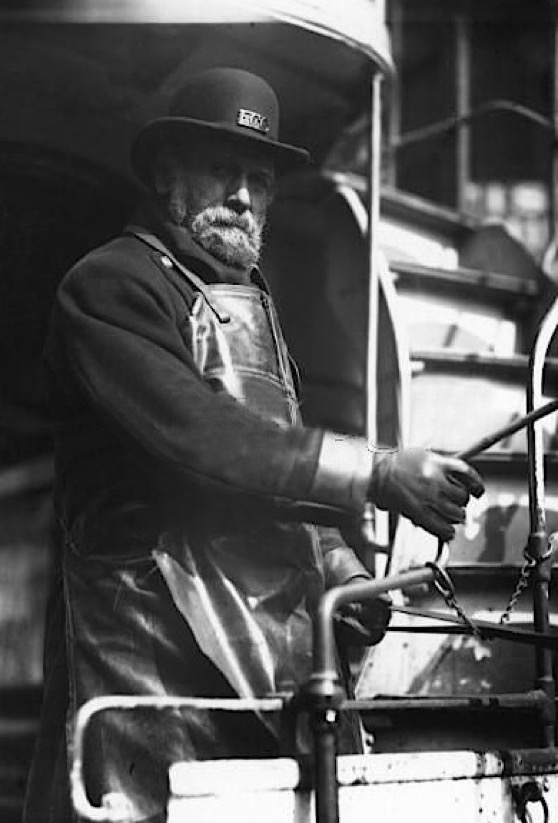
A horse tram driver, with leather apron and LCC-issued bowler hat, the latter with an 'LCC' block-capital initials badge — photo undated. Photo courtesy of the Tramways and Light Railway Society, with thanks to David Voice.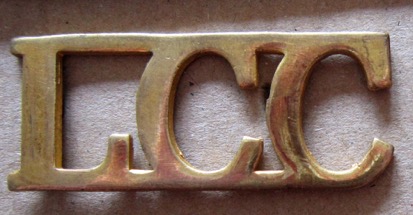
London County Council Tramways horse tram driver's cap badge — brass; used between 1899 and potentially 1914, the year the last horsecar service was withdrawn. Photo courtesy of the Prof. David Hughes Collection.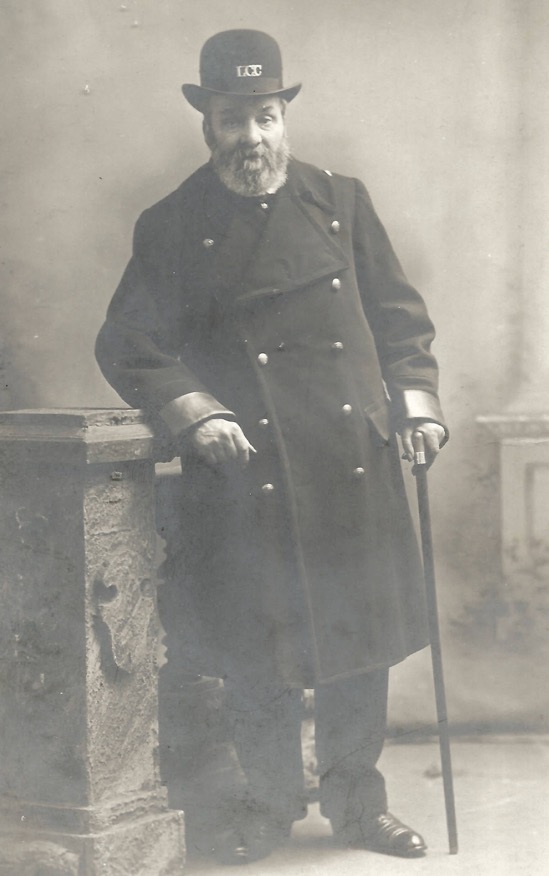
A studio portrait of a rather elderly looking LCC horse tram driver — photo undated, but as his greatcoat is in a lancer-style, it is probably mid-Edwardian. The photograph was taken at the Union Jack Studios, 61 Seven Sisters Road. Photo courtesy of the John Laking Collection.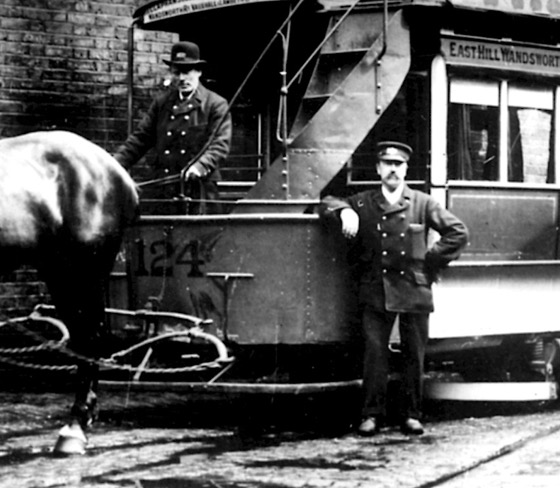
The driver of Horsecar No 124, captured for posterity with his charge outside Jews Row depot in 1903. The man leaning on the tram is probably an inspector or a regulator, given that he appears to have a pocket book inside his breast pocket. Photo courtesy of the Tramways and Light Railway Society, with thanks to David Voice.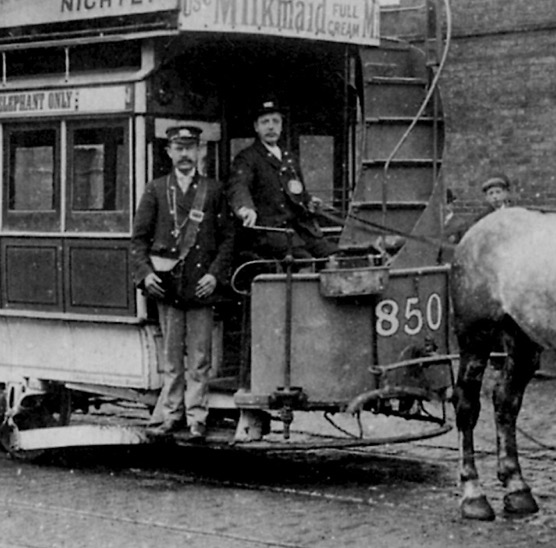
The crew of Horsecar No 850 pose outside a horsecar depot with a Greenwich to Elephant service — photo purportedly taken in 1904. The driver is George Darvill (thanks to his Great Great Grandson Matt Wallace for this information). The conductor is wearing a wreath-style cap badge (see below). Photo courtesy of the Tramways and Light Railway Society, with thanks to David Voice.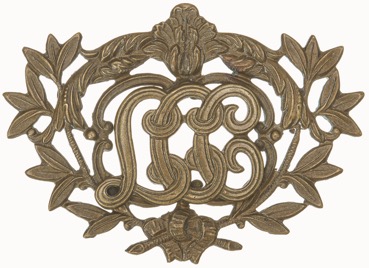
An LCCT conductor's cap badge — brass. This badge, or one with 'LCCT' rather than just 'LCC' seems to have been worn right the way through from 1899 to the takeover by the London passenger Transport Board in 1933. Author's Collection.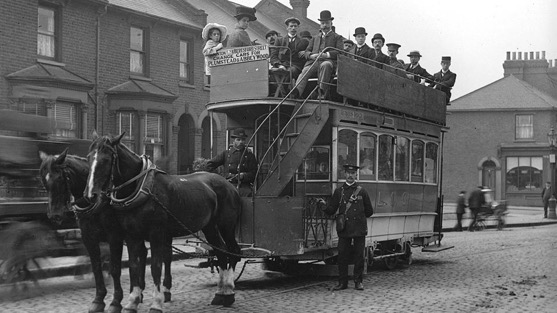
An unidentified horsecar on the Plumstead to Abbey Wood route — photo undated, but probably late Edwardian. Photo courtesy of the Tramways and Light Railway Society, with thanks to David Voice.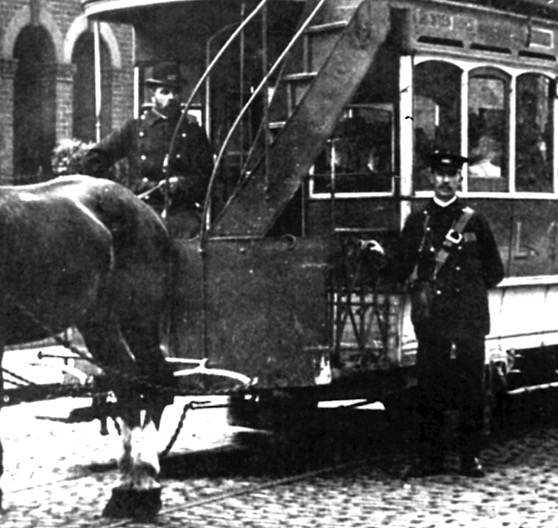
An enlargement of the above photograph showing the driver and conductor, both of whom are wearing double-breasted lancer-style coats with high, fold-over collars; the driver's is a greatcoat, the conductor's a jacket.
Cable tram drivers and conductors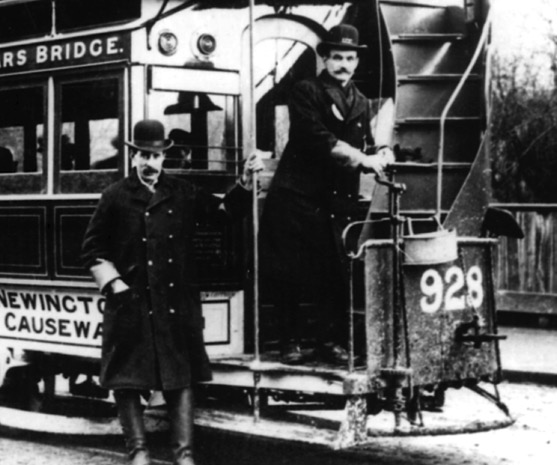
Two drivers (probably) pose for the camera with Cable Tram No 928 — a converted horsecar — on the Streatham Village to Telford Avenue cable line, probably at Brixton Hill — photo undated, but probably taken in 1903/4 given the poor condition of the vehicle (No 928 was converted to cable traction in 1898). Both men are wearing bowler hats (the man on the platform with an LCC initials cap badge) and long double-breasted greatcoats. The man on the platform also has a licence badge on his right breast. Photo courtesy of the Tramways and Light Railway Society, with thanks to David Voice.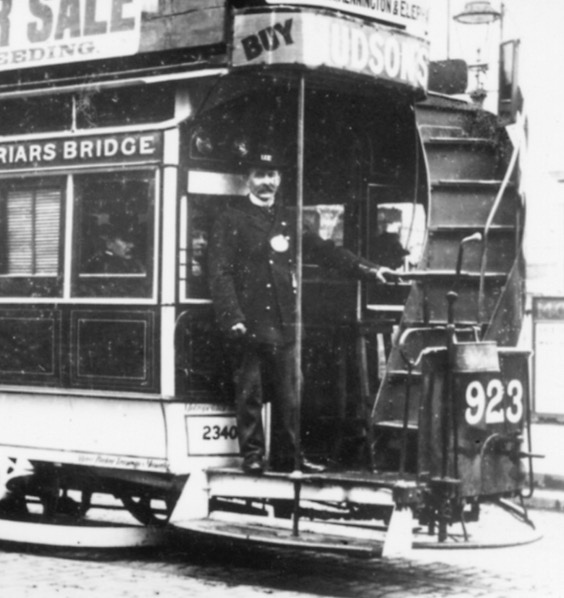
Another shot of an LCCT cable tram on the Streatham Village to Telford Avenue line, again undated, but possibly taken a little earlier than the preceding photo. The driver is wearing a double-breasted jacket with a prominent enamel Public Carriage Office licence, and a bowler hat bearing the standard block-capital 'LCC' cap badge. Photo courtesy of the Tramways and Light Railway Society, with thanks to David Voice.
Motormen and conductors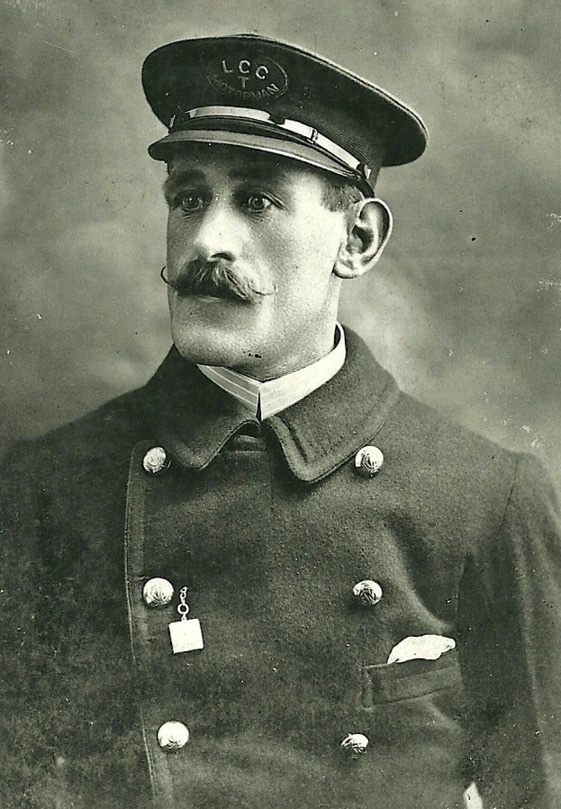
An LCCT motorman wearing a tensioned-crown peaked cap carrying an oval cloth cap badge — photo undated, but possibly taken in the mid-Edwardian era. The LCC monogram on the buttons is easily made out. With thanks to Stephen Howarth.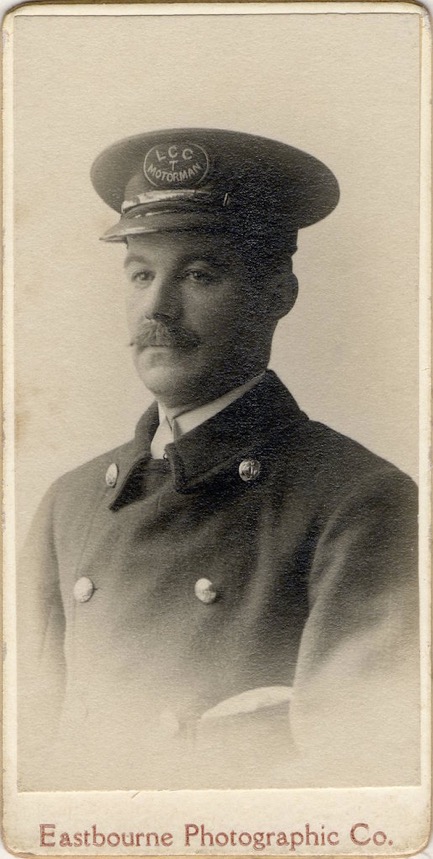
A carte de visite of an LCCT motorman — photo undated, but probably taken in the mid-Edwardian era. Photograph taken at the Eastbourne Photographic Company, which had premises at Clapham Common and Stoke Newington. Author's Collection. 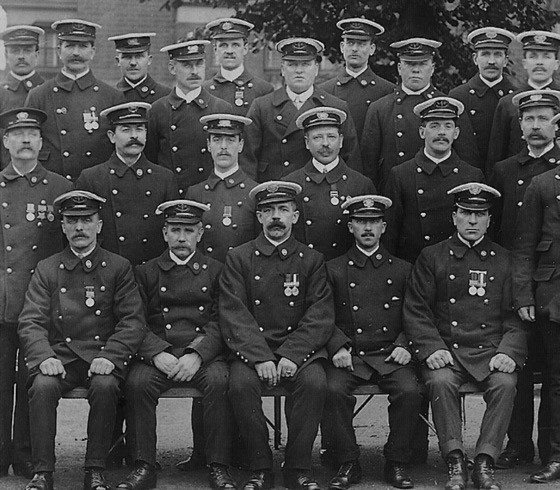
A staff photo taken outside Holloway depot — photo undated, but probably mid Edwardian. Both the motormen and the conductors are wearing double-breasted tunics and tensioned-crown peaked caps; motormen's caps bear cloth cap badges, whilst conductors' bear metal badges. The medals probably reflect Boer War service. Photo by W J Staples of Seven Sisters Road; courtesy of the LCC Tramways Trust Collection, with thanks to Dave Jones.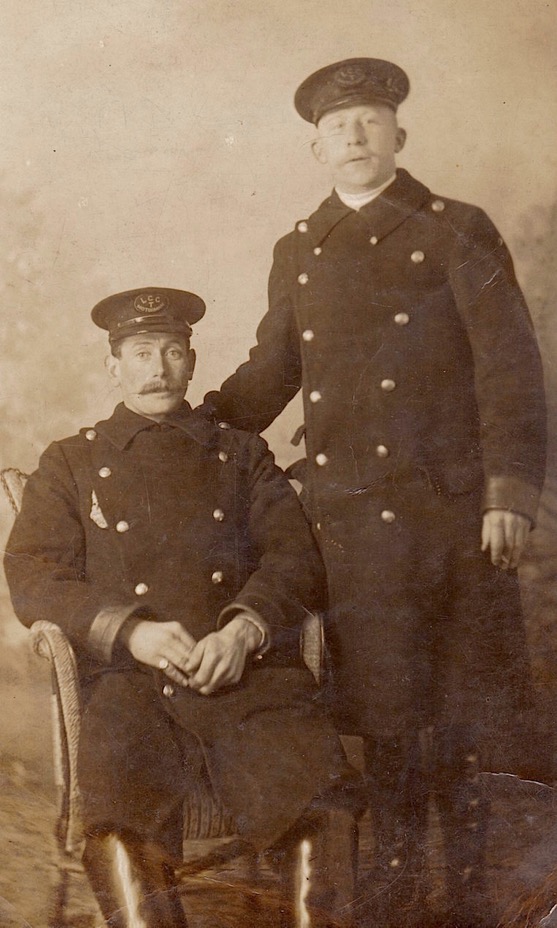
A studio portrait of two LCCT motormen in lancer-style greatcoats with high, fold-over collars. Photo courtesy of the Geoff Caulton Collection.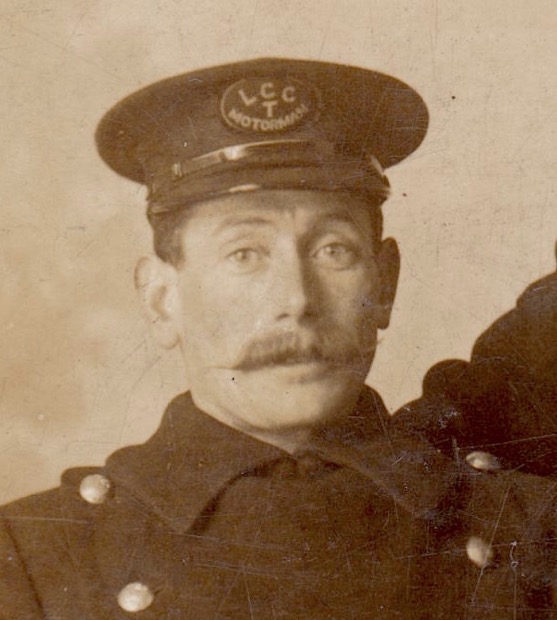
An enlargement of the above photograph showing the seated motorman; he is wearing a tensioned-crown peaked cap bearing a cloth cap badge.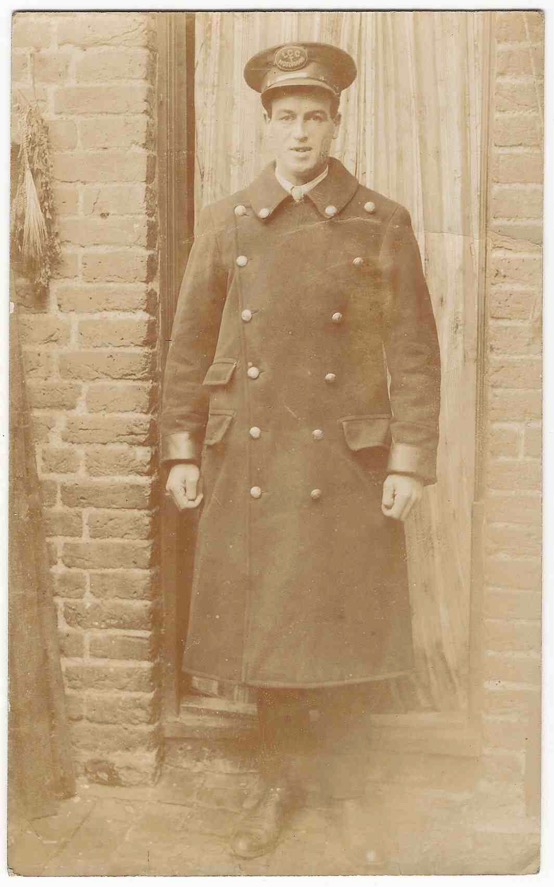
An LCCT motorman with tensioned-crown peaked cap and cloth cap badge. Author's Collection.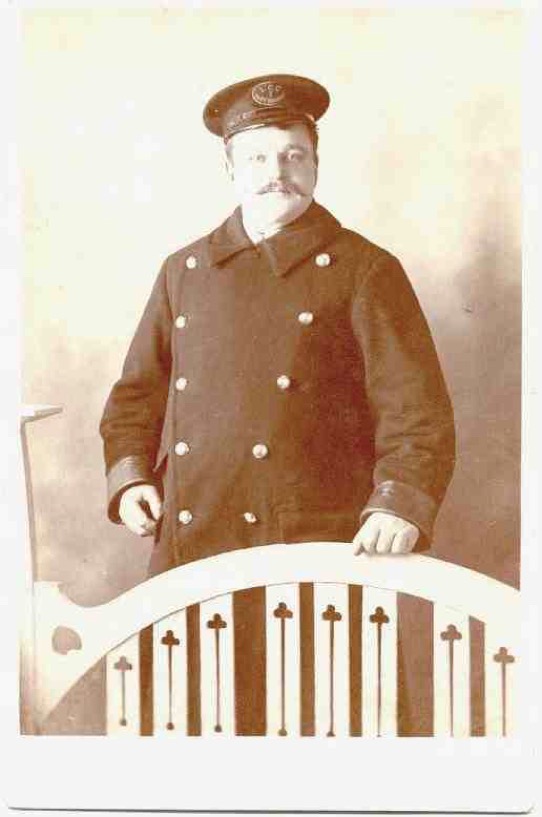
An LCCT motorman in heavy-duty greatcoat. With thanks to Stephen Howarth.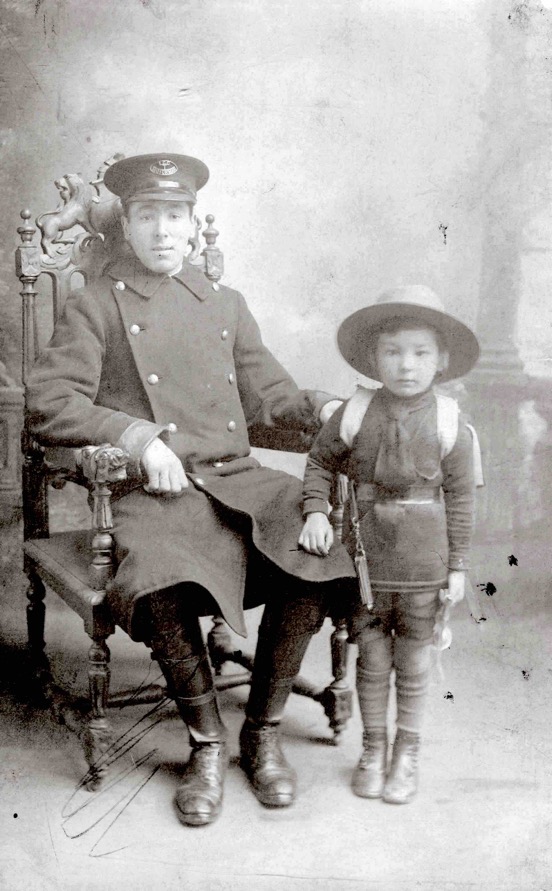
A delightful studio portrait of an LCCT motorman and a very young boy, presumably his son, who despite being dressed like a scout, looks to be way too young for the organisation (the minimum age was 11 years at this time), though he may conceivably be a Wolf Cub. The photo is undated, but was probably taken during or shortly after the Great War. Author's Collection.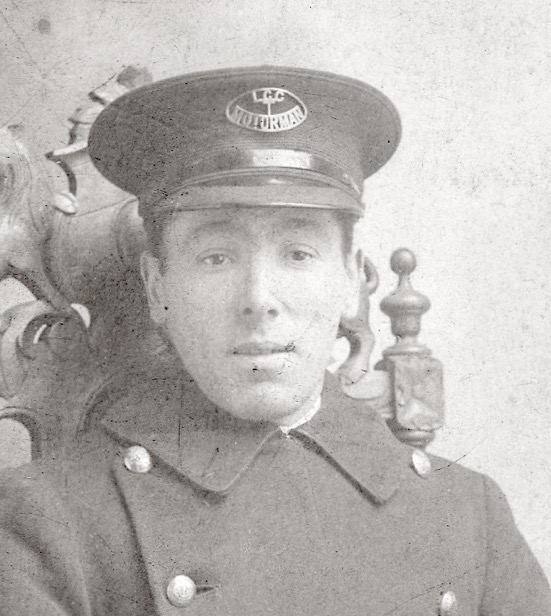
An enlargement of the above photograph showing details the cap and brass cap badge.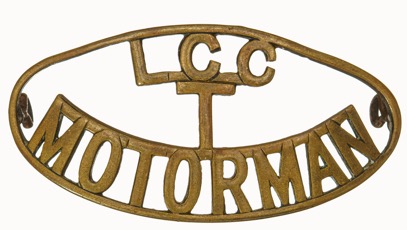
An LCCT 'MOTORMAN' cap badge — brass. This pattern of badge appears to have been worn from around the end of the Great War through to 1933.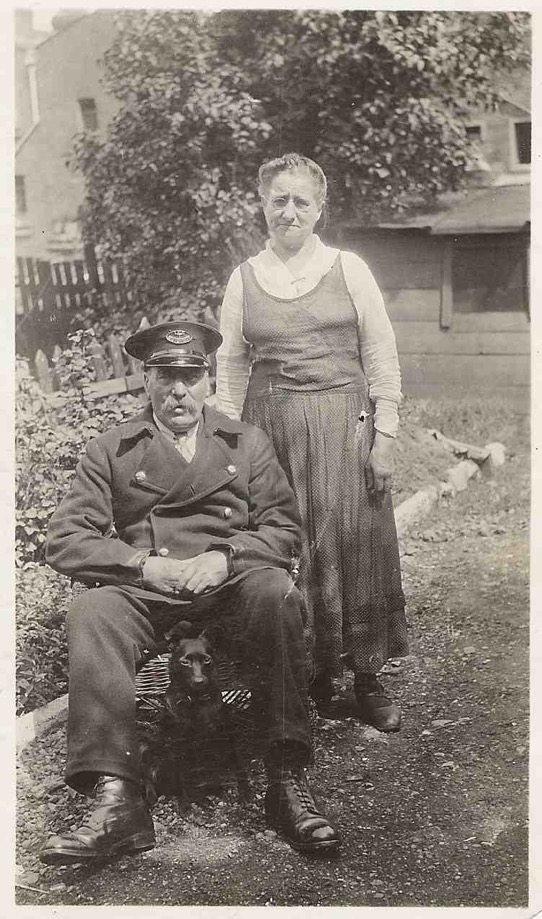
An LCCT motorman with tensioned-crown peaked cap and the later voided style of brass cap badge — photo undated, but probably taken in the 1920s. Author's Collection.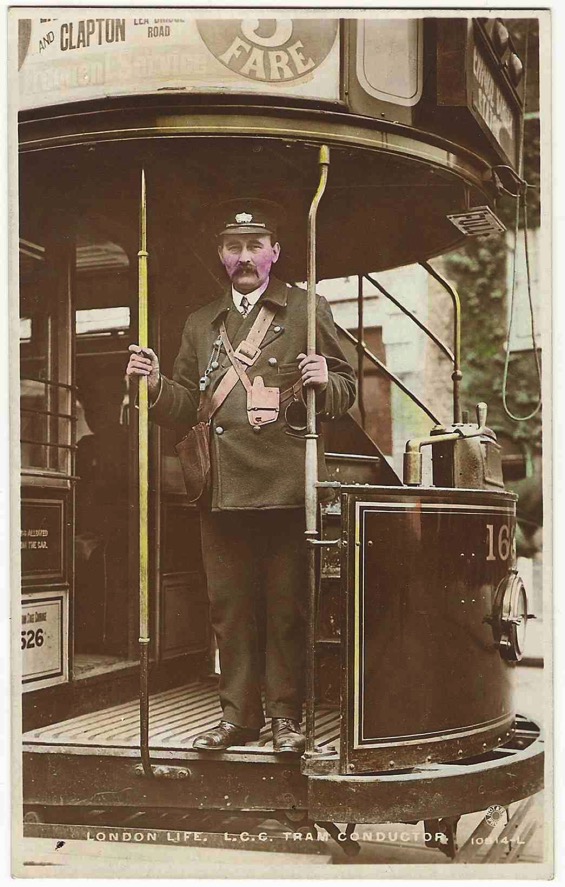
An LCCT conductor wearing a tensioned-crown peaked cap and wreath badge — photo undated, but probably taken around the time of the Great War. With thanks to Richard Rosa.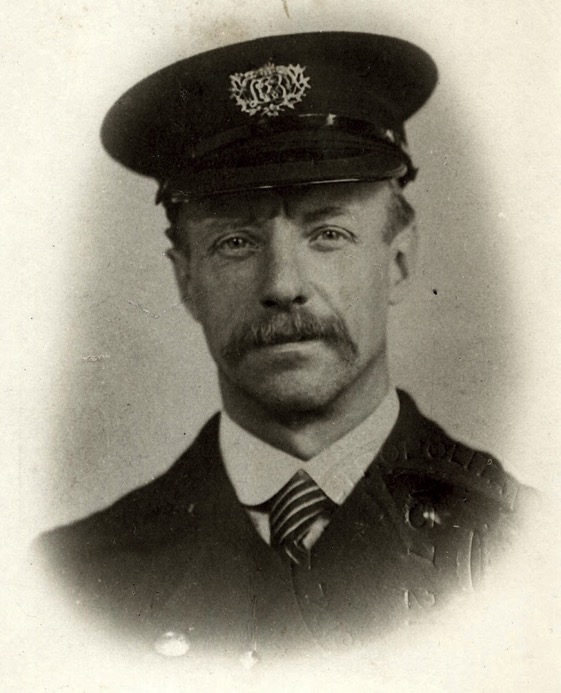
LCCT Conductor Philip Charles Barker, who was born in 1876 and died in 1922 — photo undated, but probably taken shortly after the Great War, when he would have been in his early forties. The initials in the centre of the badge are not the same as the badge illustrated above; they are possibly 'LCCT' rather than 'LCC', though this is difficult to make out with certainty. Photo courtesy of Chris Simmons.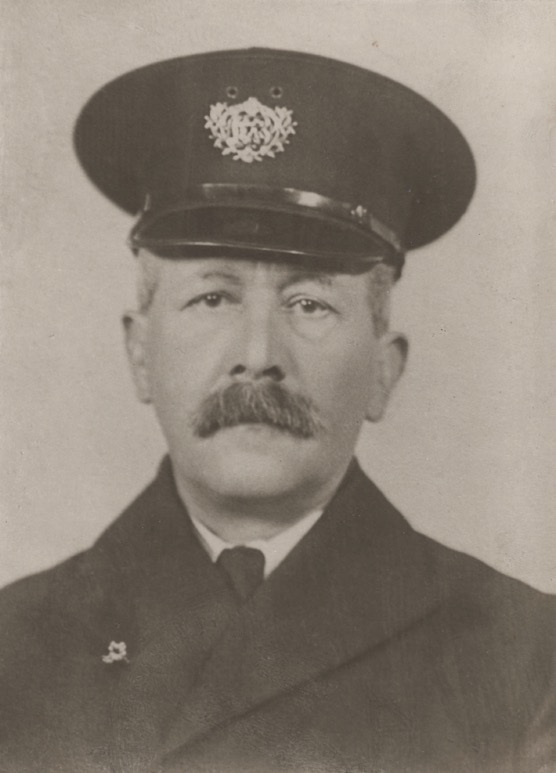
Conductor Charles White — photo undated, but probably taken in the early 1920s. Photo courtesy of the descendants of Charles White, kindly supplied by Gwendoline Smith (nee Butler).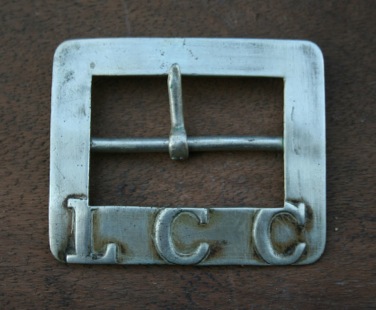
An LCCT cash-bag buckle. Photo courtesy of the LCC Tramways Trust Collection, with thanks to Dave Jones.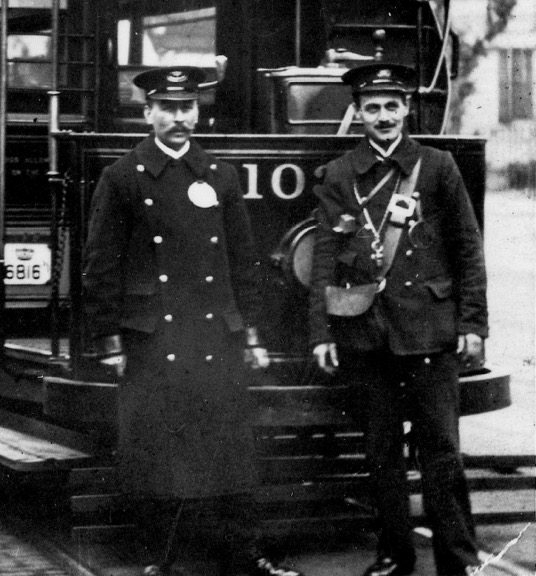
A motorman and a conductor pose in front of Tramcar No 1035 on a Route 74 service to St Georges Church — photo taken between 21st September 1921 and 21st August 1923, during which time No 1035 carried Metropolitan Stage Carriage licence plate No 6816 (see tram bulkhead). With thanks to Dave Jones of the LCC Tramways Trust for the dating information. Author's Collection.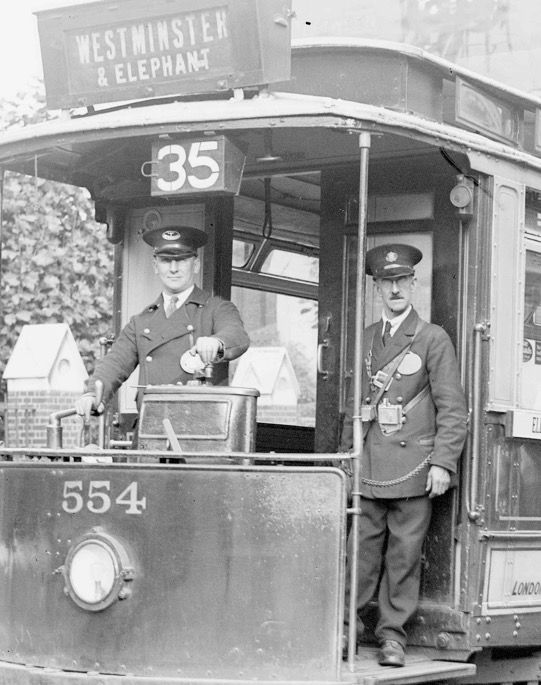
A motorman and a conductor pose for the cameraman aboard Tramcar No 554 at the Archway Tavern terminus in 1929. The difference in cap badge style between the motorman and the conductor is easily discerned. Photographer, H Nicol. With thanks to the National Tramway Museum. 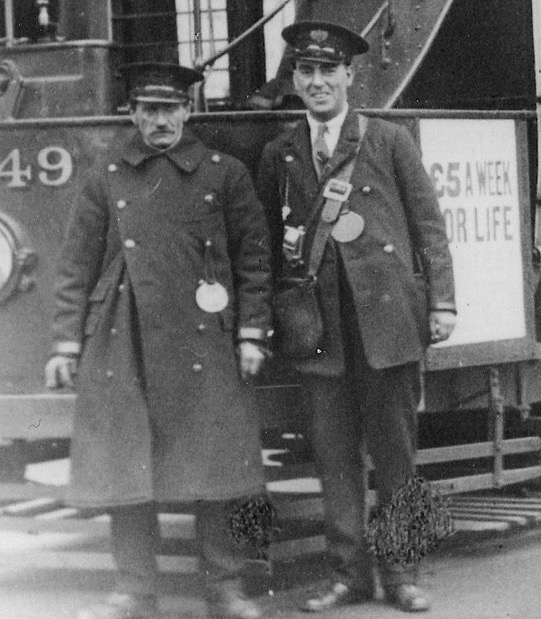
The crew of Tramcar No 1849 with a No 4 service — photo undated, but probably taken in the late 1920s. Author's Collection.
Senior staff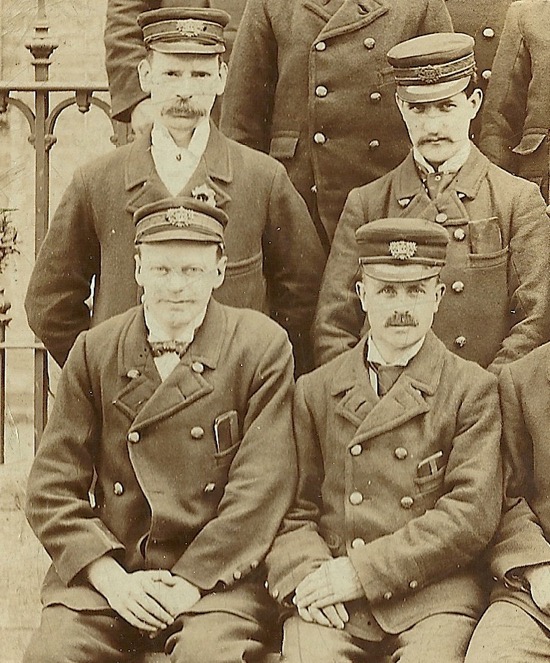
A staff photo that in view of the pocket books, would appear to show a group of LCCT regulators or inspectors — photo undated, but probably taken in 1899 when the LCC began operating its own tramway services. The subjects appear to be wearing the same style of cap badge as conductors, and in three of the four examples here, on a hat band. With thanks to Stephen Howarth.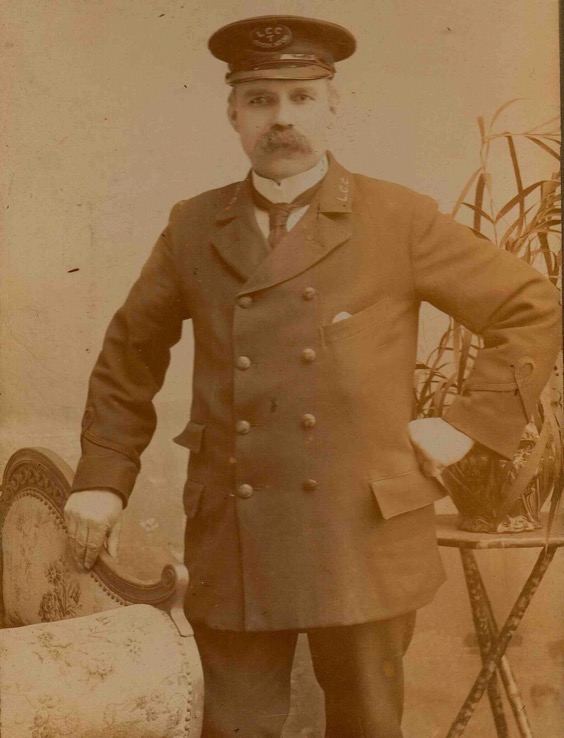
An LCCT regulator wearing a tensioned-crown peaked cap and cloth cap badge — photo undated, though taken from a Victorian mantle mirror montage with several other photos dated 1901. With thanks to Nigel Lightfoot.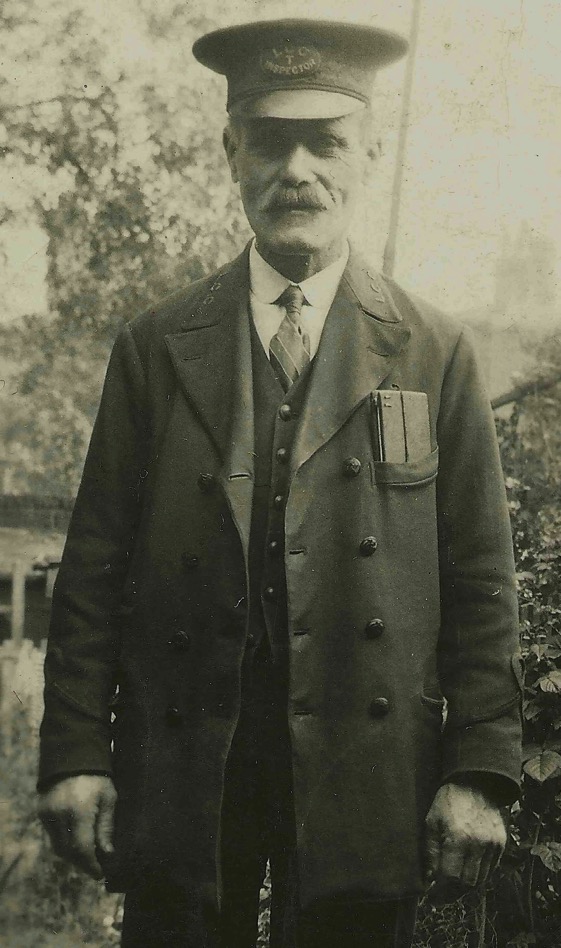
An LCCT inspector wearing a tensioned-crown peaked cap and a cloth cap badge — photo undated, but possibly early-to-mid Edwardian. With thanks to Stephen Howarth.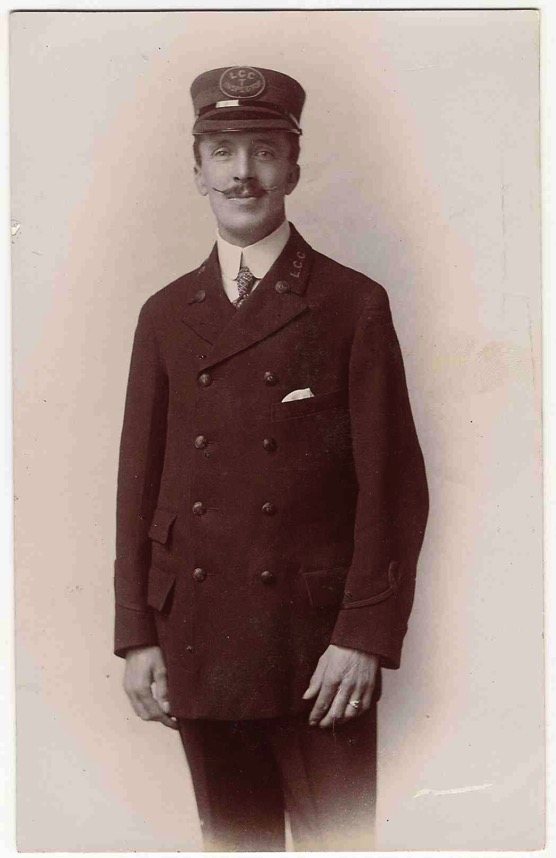
An LCCT inspector wearing a drooping-peak cap bearing a cloth cap badge — photo undated, but possibly mid-to-late Edwardian. By this time a switch had clearly been made to drooping-peak caps. The buttons are either black horn/composite or black-coated brass. Author's Collection.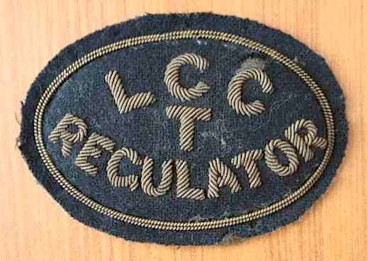
An LCCT 'REGULATOR' cap badge — cloth. With thanks to the LCC Tramways Trust Collection. These cloth cap badges appear to have been worn from circa 1900/1903 through to the end of the Great War.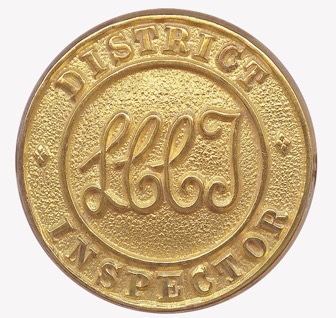
Cap badge, 'DISTRICT INSPECTOR' — brass. Possibly used from circa 1920 onwards. Photo courtesy of Stephen Howarth.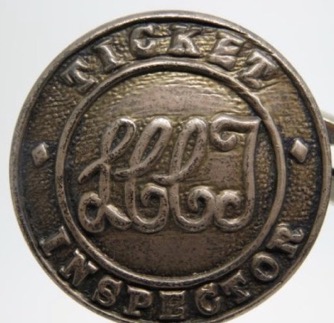
Cap badge, 'TICKET INSPECTOR' — grey metal. Possibly used from circa 1920 onwards. Source unknown.
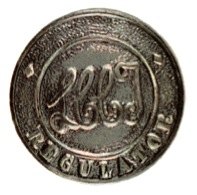
Cap badge, 'REGULATOR' — grey metal. Possibly used from circa 1920 onwards. With acknowledgement to 'Wheels of London', Times Newspapers Ltd, 1972.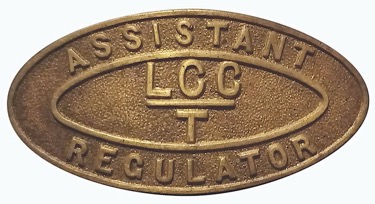
An LCCT 'ASSISTANT REGULATOR' badge — brass. Possibly worn from circa 1920 onwards. With thanks to John Burford.
Female staff
The crew of a rather careworn LCCT No 240 pose for the cameraman with a young girl, presumably a relative — photo undated, but probably taken early in the Great War, i.e., 1915. The conductress is wearing an ill-fitting topcoat and a waterproof bonnet, all seemingly devoid of insignia; moreover, there is no sign of the standard LCCT conductress jacket with its stand-up collars, which ought to be visible if one were being worn. Given that the subject appears to be wearing informal attire, this could mean that the photograph was taken before the official issue of uniforms.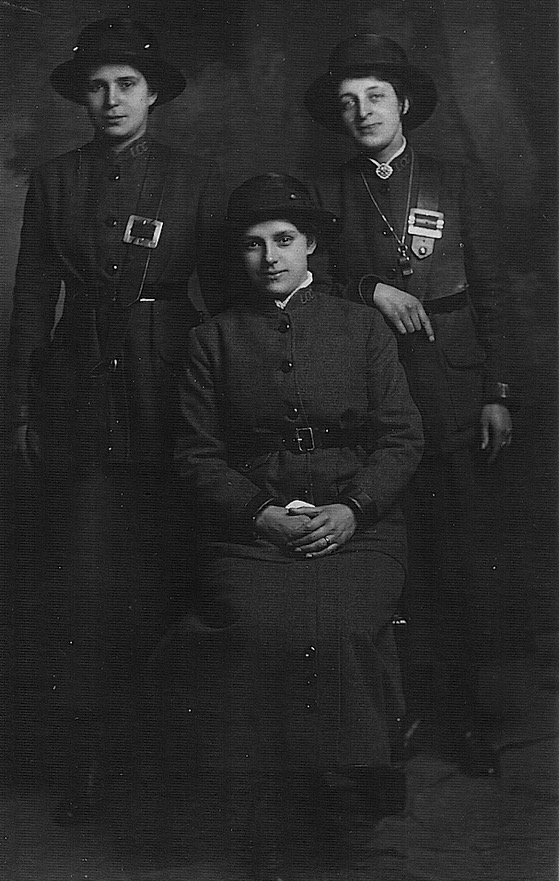
A studio portrait of three LCC conductresses. The rather utilitarian nature of the uniforms is clearly seen, as are the 'LCC' collar initials. None of the subjects are wearing cap badges. Photo courtesy of the LCC Tramways Trust Collection, with thanks to Dave Jones.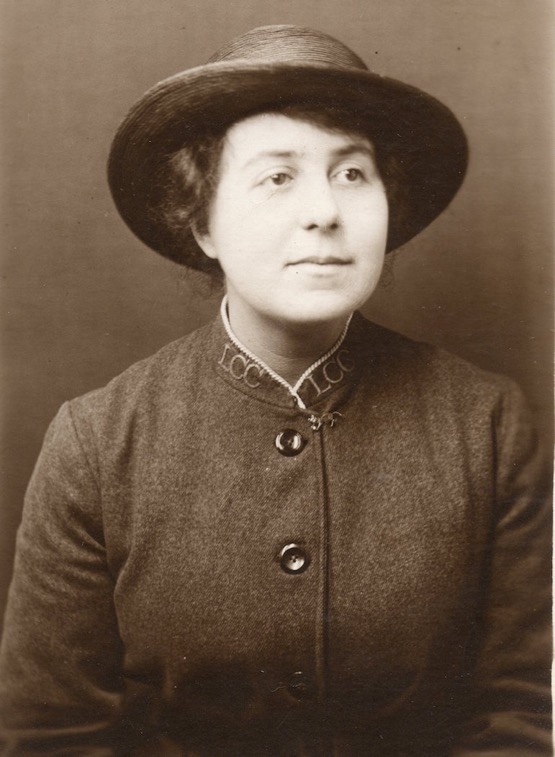
An LCCT Great War female employee, possibly a tramway conductress; her name was possibly Olivia. Author's Collection.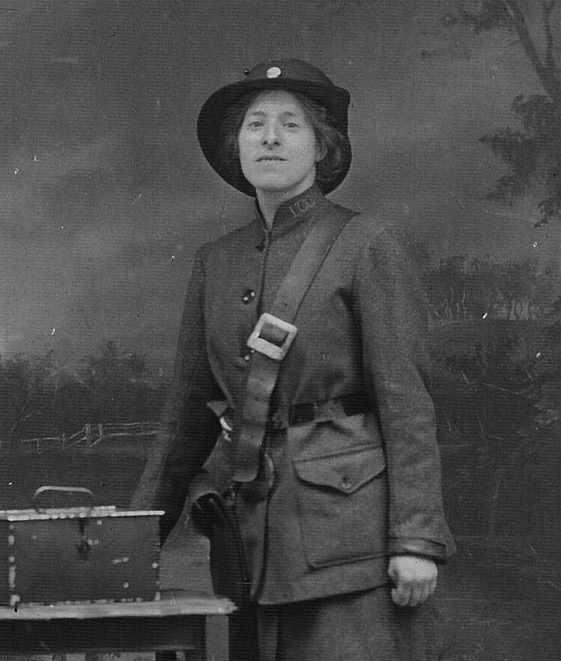
A studio portrait of an LCCT conductress — photo undated, but certainly taken during the Great War. The only uniform insignia are the embroidered 'L C C' collar initials. The cap badge is almost certainly a regimental badge. Photo courtesy of the LCC Tramways Trust Collection, with thanks to Dave Jones.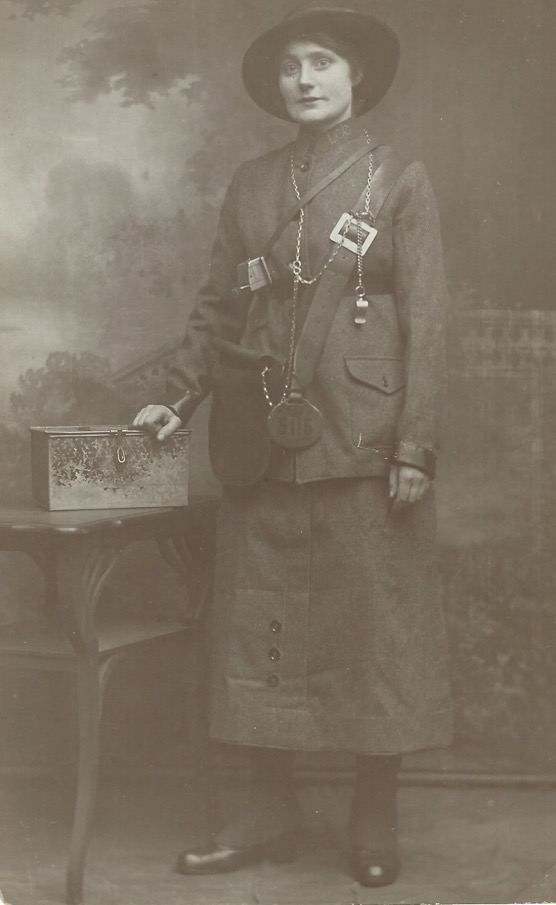
LCCT Great War Conductress Emily Elizabeth Rogers. Emily was born on the 4th February 1894, so would have been in her early 20s when the photograph was taken. Her PCO licence badge is No 5115. In the 1911 census Emily was stated to be a 'feather curler'; she was apparently very pleased to get a war-time job on the trams as opposed to working in a munitions factory. She met her future husband, a returning soldier, in London, marrying him in his native Leeds in December 1918, where she lived until her death in 1974. Photograph and background information courtesy of Margaret Stark, Emily's granddaughter.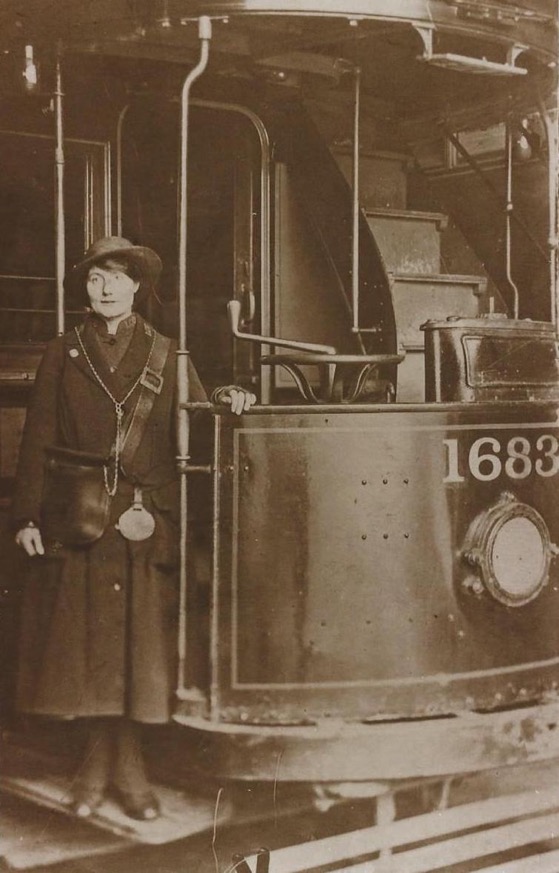
Another photograph that is believed to be of Conductress Emily Elizabeth Rogers, this time with LCCT Tramcar No 1683. She is wearing a rather unflattering topcoat, which has 'LCC' initials embroidered onto both collars. Photo courtesy of Margaret Stark, Elizabeth's granddaughter.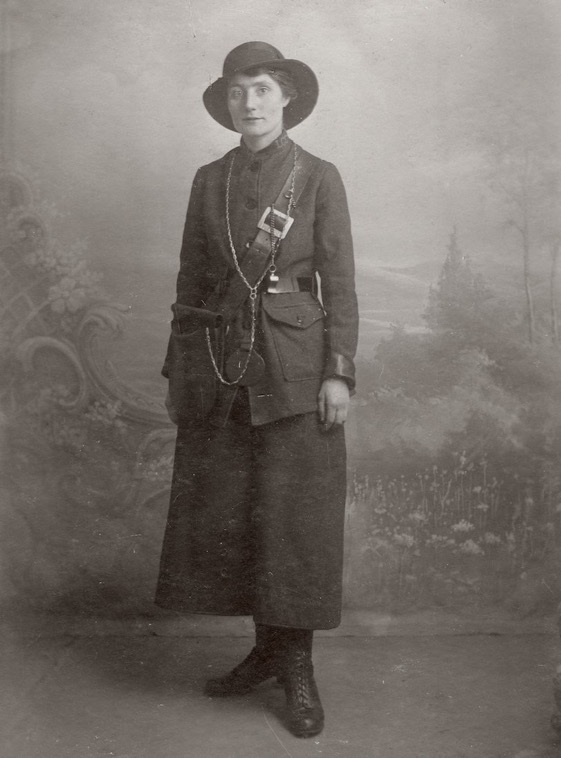
A studio portrait of an LCCT Great War conductress, who bears a striking resemblance to Conductress Emily Elizabeth Rogers above. Author's Collection.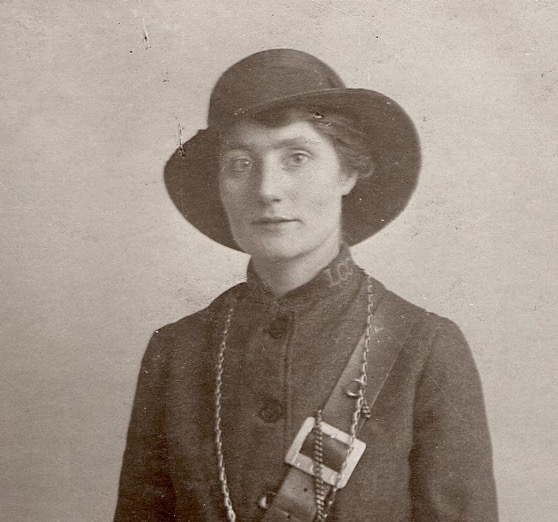
An enlargement of the above photograph showing details of the uniform and collar insignia.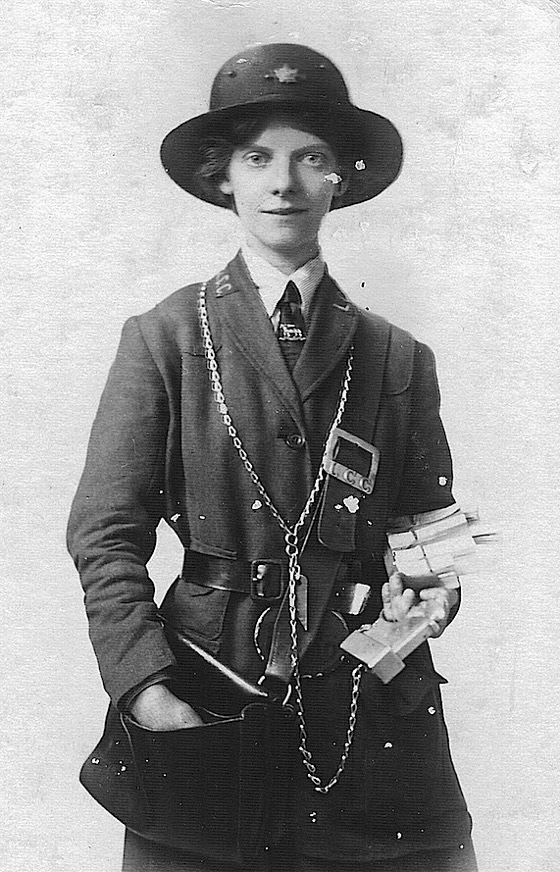
An LCCT conductress called Violet, in what is possibly her winter uniform — photo dated 1917. The badge on her cap would appear to be a Canadian Expeditionary Force regimental cap badge (thanks to Jim Barker for this information), whilst the sweetheart badge on her tie appears to be a Queens Royal Regiment (West Surrey) cap badge. Photo courtesy of the LCC Tramways Trust Collection, with thanks to Dave Jones.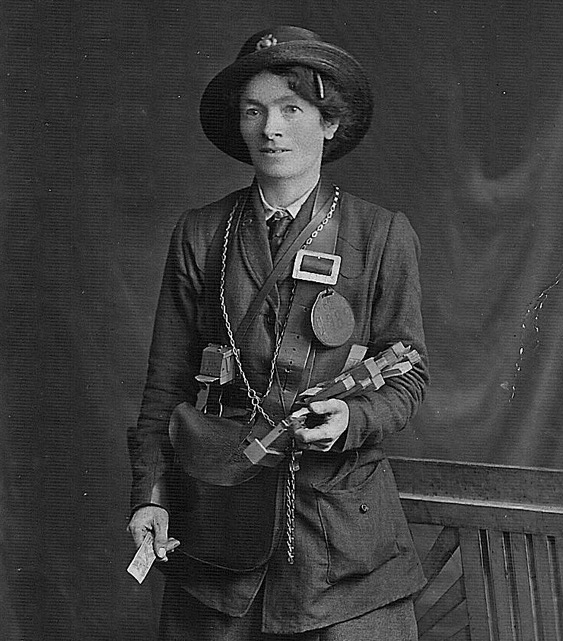
Another studio portrait of an LCCT conductress — photo undated, but certainly taken during the Great War. The subject is wearing a regimental badge on her bonnet, which would appear to be a Royal Marine Light Infantry cap badge; the bonnet itself has been turned up at the sides, giving it a more fashionable feel. Photo courtesy of the LCC Tramways Trust Collection, with thanks to Dave Jones.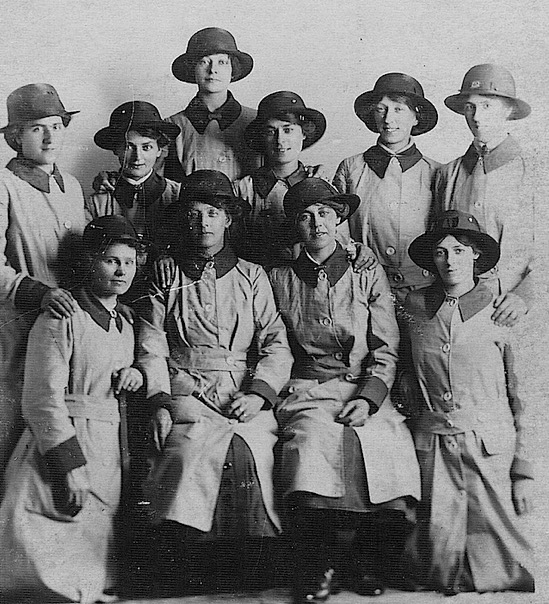
A group of LCCT conductresses in their summer raincoats — photo undated, but certainly taken during the Great War. Photographer Emberson of Wimbledon, Surbiton & Tooting. Photo courtesy of the LCC Tramways Trust Collection, with thanks to Dave Jones.